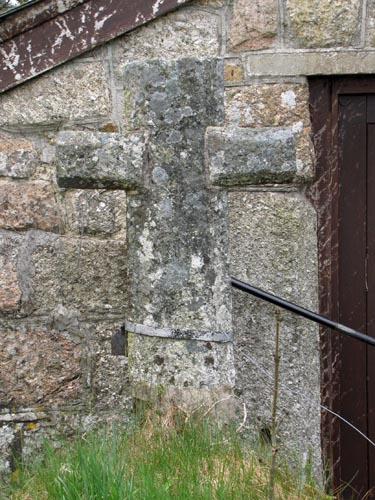
 |
 Location:
Enter the churchyard by the lych-gate gate, walk up to the main door of
the church and turn right. The cross is at the end of the path beside a
stile.
Location:
Enter the churchyard by the lych-gate gate, walk up to the main door of
the church and turn right. The cross is at the end of the path beside a
stile.
O/S Grid Ref: SX/56008/67640 Longitude/Latitude (Degrees+/-): -4.03130/50.49082 Map location: Click here to view map. Purpose: Churchyard Cross Size: 5 feet 9 inches (1.75 metres) tall. 2 feet 1 inch (0.65 metres) across the arms. Information: This cross stands beside the stile at the Southern entrance to the Churchyard. The full height of the cross is not immediately visible as it is partly hidden by the bank and the stile. Leading up from the Playfield below, are fourteen steps next to a stone building. There are two steps up from the inside. At the top of the steps is a granite stile fixed between the building and the shaft of the cross. On top of the stile is a small gate, which is hinged on the wall of the building. The apse for the gate is fixed in place by a metal strap around the shaft of the cross.
In front of the cross and lying against the bank is a stone slab, propped up on its edge. It measures 1 foot 9 inches high by 2 feet 6 inches wide. In the centre of the slab is a hole, which goes right through the slab, of 5 inches in diameter. I’m afraid I don’t know the original purpose of this stone, although there is speculation that this could be a 'bulls-eye stone' or 'bull-stone'. There is a tradition along Dartmoor leats of similar granite stones with holes in them being used to allow a measured flow of water to divert from a leat to a nearby farmhouse or dwelling.
Built into the churchyard wall, on the
roadside, is the ancient and holy well of St Leonard. The field below the
churchyard is known as ‘The Playfield’ and this has always belonged to
the village *. There is an iron ring in the field which was used to tether
the bull, in the days when bull-baiting took place in the village. This
was found in 1908 by George Shillibeer, whilst
Also inside the churchyard is the Sheepstor War Memorial Cross, whilst outside the lych-gate entrance stands the Sheepstor Village Cross. * Please note that today the Playfield is in private hands and permission should be sought from the owners who live nearby before entering the field. |